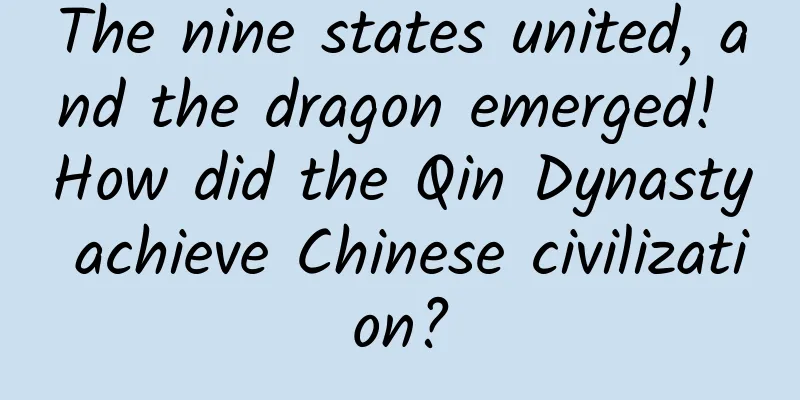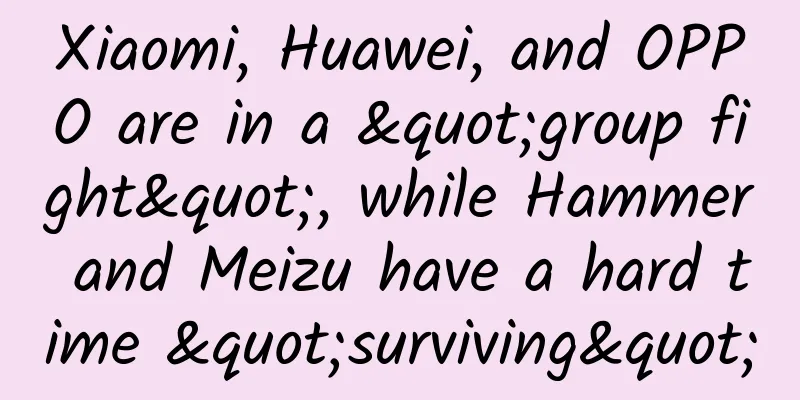The nine states united, and the dragon emerged! How did the Qin Dynasty achieve Chinese civilization?

|
Mentioning Qin In every Chinese heart It has its presence People admire the grandeur of Qin Shihuang's Mausoleum The majesty of the Terracotta Warriors (Please watch horizontally, Terracotta Warriors and Horses of Qin Shihuang's Mausoleum, photographer @张天柱) ▼ Thinking back to the Qin Dynasty building the Great Wall in the north The grandeur of "repelling the Xiongnu for more than 700 miles" (Please watch in horizontal mode. The brightly lit Simatai Great Wall is like a yellow dragon, marching forward in the thunderbolt. This picture is for illustration only. The above quote is from "On the Qin Dynasty" by Jia Yi of the Han Dynasty. Photographer: @许晓平) ▼ Admire "The King of Qin swept across the world, looking so majestic" The heroic spirit of "swinging the sword to cut through the floating clouds, and all the princes come to the west" (The above quote is from Li Bai's "Ancient Style: The King of Qin Sweeps the Six Kingdoms" in the Tang Dynasty. The picture below is an artistic representation of Qin's annexation of the six kingdoms. After Qin unified the six kingdoms, its political power dominated the earth. At that time, no country was more powerful than Qin. Map by @松楠&张琪&高麗倩/Planet Research Institute) ▼ In the textbooks of every 13-year-old in China It's clearly written Qin unified China "Established the first unified multi-ethnic feudal state in Chinese history" The Importance and Significance of the Qin State Everyone knows But few people ask again Where did it come from? How did it win? In fact Qin went from an inconspicuous corner to the center of the stage It took at least 500 years and 30 generations of life. After it unified the country It collapsed in just 15 years. Shorter than the anime "Qin's Moon" Daqin is not the final winner The final winner is "China" The story this time Starting from humiliation 01 Outside Dog Fire, Fire The raging fire destroyed the magnificent palace Devoured by the last Shang king To us, he is called King Zhou For the Ying clan at that time They lost their monarch, their greatest support. Ancestor of the Ying clan He was a "founding hero" of the Shang Dynasty and was always treated with great favor. The Zhou people who forced King Zhou to death established the "Western Zhou" The Ying clan followed the descendants of the Shang king to launch a counterattack But it was quickly suppressed (The bronze Li Gui, with the inscriptions on it, records the epic of the transition from Shang to Zhou Dynasty, photographer @路客看看, map @张琪/星球研究院) ▼ Treat like a stray dog The Ying clan was driven to the wild land in the west "Xiquanqiu" (now in Tianshui, Gansu) Accompanying the uncivilized Rong people The Zhou people transformed themselves into the Zhou emperor and the Zhou royal family. The company has been operating in Guanzhong for about 200 years. At that time The absolute protagonist on the historical stage The Zhou royal family belonged to the Ji clan They practice primogeniture The bloodline of the eldest son of the royal family is the main The second son of the legitimate wife and the son of a concubine are the minor clans and are given fiefs as princes. The "small clans" that emerged from the princes were further divided into ministers and officials. As a result, "(the Zhou royal family) established 71 states, of which 53 were surnamed Ji." The remaining princes who were not surnamed Ji, the surname Ji would marry them (The above quote is from Xunzi: Confucianism, drawn by @张琪/Planetary Research Institute) ▼ For the Zhou royal family The family and the world are one The Ying clan is not in this "family" It had no land, no cars, no bronze vessels. Poor and penniless It was only under the jurisdiction of the Zhou Dynasty. At the westernmost end and the edge, there is The weak Ying clan can only become "licking dogs" Rushing to serve the Zhou royal family Begging for a way to live Survival in the relatively arid Xiquanqiu Mainly rely on hunting and animal husbandry Raising horses and driving carriages became the specialties of the Ying clan. Among them there is a "Bo Le" who can "recognize a good horse" (The terracotta horse riders were unearthed from Qin Tomb No. 28057 at Taerpo, Xianyang, Shaanxi. They are the earliest terracotta horse riders discovered so far. Photographer: @Sing行摄影) ▼ One of the leaders of the Ying clan drove the chariot for King Mu of Zhou. Another leader raised horses for King Xiao of Zhou They saw the prosperity and wealth of Guanzhong Longing to stay in Guanzhong But they are of low status Many Ying clan members are like pigs and dogs. The kings and princes bought, sold, given away, and discarded them at will. When the Rong people in the western border harassed the central dynasty from time to time King Xiao of Zhou then thought of the Ying clan, which was close to him. Raise their status to "Vassal" Build a city in Qinyi (now Zhangjiachuan, Gansu) to resist Rongdi From then on, Qin became the clan name of the Ying clan. (Please watch in horizontal mode. Guanshan Ranch is located at the junction of Long County, Baoji City, Shaanxi Province and Zhangjiachuan, Gansu Province. This is where the ancestors of Qin Shihuang raised horses. Photographer: Liu Supei) ▼ So what is a vassal? It's not some kind of prince. It is an existence that depends on the princes. They were not even qualified to pay tribute directly to the Zhou emperor. It's ridiculous that they worked for the King of Zhou for many years. But not even a vassal Facing the increasingly fierce attacks of the Rong people The status of the Qin people also became higher and higher King Xuan of Zhou conferred the title of "Grand Doctor" on the leader of the Qin people There were small victories in the battle against the Rong people. Also added as "Xichui Doctor" Although the Zhou royal family used it as a dog to defend against the Western Rong The Qin people still did not give up their dreams Another leader (Duke Xiang of Qin) Actively moved the tribe to Weiyi (now Longxian County, Shaanxi) Weishui (now Qianhe River) flows through here and merges into Weihe River. This is a natural way to enter Guanzhong The Qin people are like standing at the gate of Guanzhong Ready to go (A diagram of the Qin capital during the Western Zhou Dynasty. As to whether Weiyi was the Qin capital, there is no consensus in the academic community. This article is based on the viewpoint in the book The Rise of Yongcheng compiled by the Museum of the Mausoleum of the First Qin Emperor. Map by @松楠/星球研究院) ▼ From Xiquanqiu to Qinyi and then to Weiyi The Qin people have been moving closer to Guanzhong Compared with the prosperous Guanzhong The edge of their activities Just like "chicken ribs", it is tasteless to eat but a pity to throw away They stood at the gate of Guanzhong and watched They also want to eat meat But the princes of the Ji clan who were well fed and well-fed Keep them out of the door Until they met someone That man is King You of Zhou 02 Tiger in a cage That's right This is the King You of Zhou who played tricks on the princes by lighting beacons. During his reign The Rong people entered Guanzhong Conquered the capital (Haojing) and killed King You of Zhou Historians define it as "The Western Zhou Dynasty fell and the Eastern Zhou Dynasty (Spring and Autumn Period and Warring States Period) began" (The bone tube with line-carved hunting patterns, the warrior hunting picture engraved on it, the composition style, line carving technique and character image are very different from Chinese craftsmanship. It must be from a foreign country or a work influenced by foreign culture. The picture comes from @Gansu Provincial Museum, and the map is @Zhang Qi/Planet Research Institute) ▼ From then on, the Zhou emperor was just a puppet. The princes divided up the royal property through him. The Qin people helped the Zhou emperor move away from Guanzhong Got some benefits The Zhou emperor recognized it in his own name The leader of the Qin people (Qin Xianggong) was a vassal The land west of Qishan in Guanzhong was given to them. The Qin State was officially established (Please watch in horizontal mode, the fertile land of Guanzhong next to the mountains, photographer @陈剑峰) ▼ but The title of Zhou Emperor is no longer valuable Guanzhong is now ruled by the Rong people The Qin people wanted this land Only fists can speak that's all The Qin people fought hard with the Rong people for 4 years, but all ended in failure. Duke Xiang of Qin himself also died in the war against the Rong people. The Qin people found themselves sitting at the table of the great power game I don't have any chips in my hand I only have brute strength and a miserable life. "Qin Feng Wu Yi" in the Book of Songs This is a true portrayal of this period. As the battle approached, Qin Jun shouted angrily "Who said I don't have a uniform?" The soldiers will respond in unison "I will wear the same robe with you!" Then they shed their blood together on that yellow land That is a kind of monarch and minister who depend on each other for their lives. The sadness that can never be reversed (Stone armor of the Qin Dynasty, hidden in the Shaanxi Archaeological Museum. Each Qin person is like a piece of armor, forming an indestructible Qin Dynasty. Photographers @张天柱、白阳, map @张琪/星球研究院) ▼ With the courage to face death The Qin people "conquered the King of Rong, added twelve states, and opened up a thousand miles of land" Gradually and violently suppressed the Rong people After a conquest of Rongdi The Qin State established the earliest county in Chinese literature Previously, the Zhou emperor managed the country through The princes were enfeoffed and the eldest son inherited the throne, forming a separatist regime The Qin State divided "counties" into administrative units. Local governors were directly appointed and dismissed by the monarch rather than being hereditary. Advanced systems flourished in Qin Outside the Rong people Guanzhong, the former homeland of the Zhou royal family The Zhou people had status, culture, and technology Descendants of merchants from the previous dynasty It was also slowly absorbed and digested by Qin Bronze ritual vessels and military chariots that did not exist before Brick and tile palaces appeared in the Qin State The Qin State greedily absorbed all cultural nutrients (The Qin Gong Bi from the Spring and Autumn Period was unearthed from Taigong Temple in Chencang District, Baoji City. The above quote is from "Records of the Grand Historian: The Basic Annals of Qin". There is no consensus in the academic community as to whether Qin conquered the descendants of the Shang people. This article adopts the viewpoint of Lin Jianming's "Draft History of Qin". Photographer @梦物如颜) ▼ The King of Qin learned the etiquette of the Zhou Dynasty On Yongshan Sacrifices on behalf of the Zhou emperor To show high status and authority (Please watch in horizontal mode. The Yongshan Blood Pond Site is located in Fengxiang, Shaanxi. The total area of the site is 4.7 million square meters, including more than 3,200 buildings, sites, roads, sacrificial pits, etc. This is the earliest, largest, most clear, longest-lasting, and most complete national large-scale sacrificial site from the Qin and Han dynasties that has been discovered and recorded in ancient documents. Photographer: Li Minchao, map: Zhang Qi/Planetary Research Institute) ▼ The Qin ruler used the Zhou people's site selection and construction technology to On the side of Yongshan Mountain (now Fengxiang, Shaanxi) Created a " Qin Capital on Water " from scratch That is "Yongcheng" Its exterior is surrounded by water Surrounded by Yongshui River and Zhifang River Tashi River and Fenghuangquan River A natural defense facility The interior is built along the river. The Baiqi River flowing down from Yongshan Mountain Many rivers run through the city Roads are built along rivers, and people live along the rivers This is how the "Book of Songs·Qinfeng" came about. "The so-called beauty is on the other side of the water" (Qindu Yongcheng illustration, map by @李雪茜&高麗倩/Planet Research Institute) ▼ 19 Qin Jun planned their business here Yongcheng also became the longest-established capital of the Qin State. When the Rong people's envoys saw the palace of Yongcheng I can't help but sigh, "If I ask a ghost to do it, it will be a lot of trouble." (The ghosts and gods must have been very troubled to build this palace) The Qin people also proposed a more ambitious goal in Yongcheng "My descendants drink water from the Yellow River" (The iron sword with a gold handle inlaid with turquoise and snake pattern is known as the "Star of Qin Swords". It was unearthed in Tomb No. 2 of Yimen Village, Baoji, Shaanxi Province in 1992. The above quote is from "Historical Records: The Book of Qin". Photographer @梦物如颜, map @张琪/星球研究院) ▼ To understand the goal of this Yellow River drinking horse We must open up the God's perspective To observe the Qin State and its neighboring Jin State The geographical relationship between Although the Qin State had established a firm foothold in Guanzhong at that time But the mountains around Guanzhong plus the Yellow River Suppressed the expansion of Qin Like a "beast in a cage" The Hangu Pass controlled by the Jin State It's the "door lock" and the "key" The Qin State was firmly locked in a "cage" (Sketch of the confrontation between Qin and Jin during the Spring and Autumn Period, drawn by @松楠&高麗倩/Planetary Research Institute) ▼ With Qi, Jin, Song, Chu, Wu Compared with the great Eastern countries that were enfeoffed by the Western Zhou Dynasty Qin was a very young country. The Western Zhou Dynasty was just established after its demise The national development cycle is at least one or two hundred years behind After the conflict between Qin and Jin began (576 BC) The State of Jin defeated the State of Qin many times. Even deep into the Qin territory, coming and going freely The Qin State was trapped in the mountains and had no power to fight back. However, Jin did not pursue the victory. Because it is facing Intense turmoil and change (The monarch of Jin State fought for power with the Zhao family in China, and staged a "Zhao Orphan". The picture below shows the chariot and horse burial pit in the tomb of Zhao Qing in Taiyuan. Photographer @邬红波) ▼ Due to the decline of the Zhou royal family The power shifted downwards and the princes gained power Within the vassal states A lower-level official Also imitate the princes, rise up and fight for profit Land gradually changed from state-owned to privately owned The three nobles of Zhao, Wei and Han in Jin The territory of Jin was divided up in this way. It is called "Three Families Divide Jin" in history. Wei succeeded Jin The Qin State firmly locked Guanzhong (Many scholars believe that the "Three Families Dividing Jin" marked the end of the Spring and Autumn Period and the beginning of the Warring States Period. The picture below shows the Hanzhuang Great Wall in Xinzhou, Shanxi. It was built by the State of Zhao during the Warring States Period and rebuilt on the original basis in the Ming Dynasty. Photographer: @朱哲) ▼ This is a crucial "land reform" Originally, most of the harvest from the fields belonged to the state. Every farmer, no matter how much effort he puts in The rations received are roughly the same After the reform, most of the gains belong to individuals. Only a fixed tax is paid to the state In other words The more diligent you are, the richer you will be. Farmers are working hard The country's strength has also soared The Qin people made drastic changes to the country outside Still unaware Although he entered Guanzhong It is still centered on the Eastern power. Wandering on the edge of the advanced cultural circle (Bronze mirror with warriors fighting beasts from the Qin Dynasty in the Warring States Period. On the back, there are two brave warriors holding shields in their left hands and swords in their right hands, each facing a ferocious leopard, as if fighting a beast. Photographer: @柳叶氘, map by @张琪/Planetary Research Institute) ▼ Compared to the royal family at this time A great Eastern country that had been divided for hundreds of years The Qin State was a conquered nation The people sitting there were all descendants of Rong people, Zhou people, and Shang people. Almost no blood ties Burying people alive is a rare event in a large oriental country. In the Qin Dynasty, it was extremely popular and became more and more serious. Duke Wu of Qin "accompanied 66 people to die" Duke Mu of Qin "killed 177 people" The First Tomb of the Qin Emperor excavated in Yongdi The number of people buried with the deceased was as high as 186. This is the tomb with the most human sacrifices since the Zhou Dynasty The appearance of these unearthed human remains Often huddled together This suggests that they were probably like livestock. Tied and buried (Sketch of human remains, drawn by @张琪/Planetary Research Institute) ▼ also The size of Qin Gong Tomb No. 1 is very large It is the largest tomb before the Qin Dynasty. During the archaeological excavation, there were 247 robbery holes. However, more than 3,000 cultural relics were unearthed. but These burial objects are extremely simple and crude. Far behind other major countries General technical level But they were able to build such a grand tomb This shows that the Qin rulers Control the people and implement human wave tactics And the huge ability to amass resources (Sketch of Qin Gong Tomb No. 1, photographers @李文博, 郝天真, map @张琪/Planetary Research Institute) ▼ This ability stems from The relationship between the government and the people under its rule through war and conquest The Qin State implemented Strict militarized and legalized management As the saying goes (From "Marching to the Front" by Du Fu of the Tang Dynasty) ▼ "What's more, the Qin soldiers are very good at fighting and are no different from dogs and chickens when driven." Ignorance of human nature and lag in development Let the Eastern powers despise Qin as a "barbarian" Never ally with Confucius traveled around the world but never went to Qin (Tiger Talisman of Qin Du in the Warring States Period, photographer @脉影, annotated @张琪/Planetary Research Institute) ▼ The Qin State was blockaded and despised by the great powers. Like a sick "tiger in a cage" I want to go to the fertile land of the East to beg for food. Hangu Pass is the only exit But it was never a rival of Jin State. Now it is no match for Wei. Wei after the "Land Reform" It is also an active attack, deep into Guanzhong The fortifications built along the Luo River Like a sharp blade piercing into the heart of Qin At this critical moment Qin Guo met another person A person who really helped it change its fate That man's name is Shang Yang 03 Dragon Yes "Shang Yang's Reforms" History textbooks always emphasize How Shang Yang transformed the Qin State But in fact Shang Yang and the Qin State achieved mutual success Shang Yang was originally a bastard of the royal family of Wei State. Possessing high-level knowledge and insights But due to the system of primogeniture He couldn't inherit the family business and had no way out. (The seal with the character "gong" is an ancient seal of the Three Jin Dynasties in the Warring States Period. The picture comes from @乾堂焦新帅, and the map is @张琪/星球研究院) ▼ He was not the only one in this situation. Due to the hundreds of years of prosperity of the Zhou royal family A large number of capable nobles Outside the national system Their views on the way to enrich the country and strengthen the military Different schools of thought hold different opinions Shang Yang was one of them. He advocated ruling the country by law. He is full of knowledge and is in urgent need of a place to live To practice his theory and display his talents At this time, the Qin State, which militarized its people, For Shang Yang, it was a land of heaven. There is rule of law here Fertile soil for growth (Aerial photography of the Guanzhong Plain, a well-regulated land “woven” by rules and regulations, photographer @陈剑峰) ▼ Shang Yang repeatedly made suggestions and debated in Qin Fighting domestic conservatives who are unwilling to reform He persuaded the King of Qin (Qin Xiaogong) Move the capital to Xianyang, away from the old forces and old aristocrats Then, in the form of a decree Redefining the "way of survival" for the people of Qin usually Private fighting and "illegal" speech are strictly prohibited Basic industries such as farming, weaving and breeding Those who harvested more were exempted from corvee labor. Those who harvest less will be punished as slaves (Shang Yang Fangsheng in the Warring States Period, sheng is the unit of volume for weighing crops, photographer @罗巧巧, wikimedia commons, map @张琪/Planet Research Institute) ▼ Wartime Some regulations have mentioned Capture the head of an Armor Piercer You can upgrade your rank by one Plus a hundred acres of fertile land and a luxurious house The term "first class" came from this Without military merit, even royal nobles have no privileges. Facing those who violated the law Shang Yang was never soft-hearted He once ordered the execution of 700 people in one day. The flowing blood dyed the Wei River red From then on, "women and infants all spoke of Shang Yang's laws." (The above quote is from "Strategies of the Warring States: Qin Strategy", Weihe River, photographer @陈剑峰) ▼ Facing the Crown Prince who violated the law Shang Yang cut off the prince's teacher's nose Nobles who lost their privileges I wish I could eat his flesh and sleep on his skin When agriculture is the only source of wealth People will try every possible way to improve efficiency Ox-drawn plows and iron tools quickly became popular in the Qin State. The water conservancy project "Zhengguo Canal" irrigates thousands of hectares of fertile fields in Guanzhong The Dujiangyan Irrigation System in the Bashu region is still in use today. (Please watch in horizontal mode, panoramic view of Dujiangyan Irrigation Project, photographer @张铨生) ▼ When fighting is the only way to rise “When the people see war, they see meat like hungry wolves.” When two armies clash, no prisoners are taken. Specialized in beheading, very scary The Qin people's martial tradition of establishing a country through war Together with the "first-class" system Bai Qi, Wang Jian, Li Xin, Meng Tian, etc. Military generals show their power in Qin Bai Qi alone conquered more than 70 cities for the Qin State (Sketch of Qin weapons, the above quote is from "Book of Lord Shang", photographers @张天柱,柳叶氘,路客看看, map @张琪/星球研究院) ▼ Less than 30 years after Shang Yang's reforms The State of Wei was defeated and surrendered. The land on the west bank of the Yellow River and the Hangu Pass Qin finally gained full management rights over Guanzhong The basic situation is stable, we can attack or defend At this time, 443 years had passed since the Qin people first entered Guanzhong. (Please watch in horizontal mode. The largest waterfall of the Yellow River, Hukou Waterfall, was originally the boundary between Qin and Wei. After Shang Yang's reform, it belonged to Qin. Photographer: @吕桂明) ▼ The Qin State after Shang Yang's Reform Treating the people as a kind of state property A renewable resource The country is like a high-speed machine The law is enforced absolutely This is another great country formed by the reproduction of relatives. What can't be done The Qin State after Shang Yang's Reform Positions and ranks are determined by people's abilities It itself is a fusion of many ethnic groups such as Rong people and Zhou people. It is common for people of different races and surnames to hold high positions This is also the case with other major countries where relatives control the court. Incomparable (The "foreigners" among the high-ranking officials of the Qin State indicate that Shang Yang, who made great contributions to the Qin State, was also a "foreigner". However, the Qin people did not thank Shang Yang. After losing the power support of the Qin monarch, the Qin people "tore Shang Yang apart with five horses". Map by @张琪/星球研究院) ▼ And the reform of Qin State was behind other great powers. No more crossing the river by feeling the stones It takes advantage of the “latecomer advantage” Overtaking on the curve in the era of great changes More than 400 years of efforts Not as good as these 30 years of earth-shaking changes in this way The Qin State completed the transformation from a cicada to a dragon Breaking out of Hangu Pass Opened the way eastward The troops are at the throat of the nations (The rise of Qin and the assassination of the King of Qin [Qin Shi Huang] are stories from this period. Although everyone knows that "once a warrior leaves, he will never return", living in the face of death is also a kind of bravery. Map by @张琪/Planetary Research Institute) ▼ The Eastern powers decided to "cooperate" That is, the longitudinal (north-south) connection forms a barrier Want to turn Qin into a beast Put it back into the "cage" in Guanzhong The Qin State used the strategy of "lianheng" That is, horizontal (east-west) lobbying and joining forces with other countries "Make friends with distant countries and attack nearby countries" to defeat them one by one Every time a country is destroyed The King of Qin built This country-style palace (Sketch of the royal buildings in Xianyang, Qin Dynasty, drawn by @高麗倩&李雪茜/Planet Research Institute) ▼ Like autumn wind sweeping fallen leaves Qin took over all the countries Unified writing and currency Standardized weights and measures, and standardized track systems … finally The Qin king who unified the world became Qin Shi Huang All the troops in the world gathered in Xianyang (The above text is adapted from "On the Qin Dynasty" by Jia Yi of the Han Dynasty. The picture below is the Terracotta Warriors. Photographer: @李文博) ▼ To ensure peace in the world, we must first build roads The "highway" connecting the whole country (Qinchi Road) Stretching across the land Qin Shi Huang toured the territory along this route at the same time Qin Shi Huang's Mausoleum and Terracotta Warriors The Great Wall, Afang Palace and many other unprecedented " Super Project " Roll out across the country The production process of the Terracotta Warriors and Horses of Qin Shihuang's Mausoleum Like manual 3D printing Explosive growth in technology (Diagram of the production of the Terracotta Warriors, drawn by @韩佳琪&张琪/Planet Research Institute) ▼ The Terracotta Warriors are equipped with Arrowhead head outline Compared to today's semi-automatic rifle bullets Very similar A total of 40,000 arrowheads Average deviation of the base of each arrowhead Only 0.83 mm This is what is known so far The earliest large-scale "standardized" production (Terracotta Warriors bow and arrow, photographer @张振华, Lao Tubao Sun Yan, map @张琪/Planet Research Institute) ▼ The bronze chariot and horses in the Mausoleum of Qin Shihuang are even more A sensitive machine made up of more than 3,000 parts It uses the earliest known anti-rust technology Wire drawing process, welding process, inlay process Casting process, casting and forging combined process Hollow casting process, loose-leaf connection process, button ring connection process Snap-button connection process, snap-button plus pin connection process And so on and so forth… Horse head tassel decoration The diameter is less than 0.5 mm, as thin as a hair All are cast The entire chariot can be called the " Crown of Bronze " (Please watch in horizontal mode, the bronze chariot and horses in the Mausoleum of Qin Shihuang are shown by @老土豹孙岩, Li Wenbo, and Zhang Tianzhu, and the map is by @张琪/星球研究院) ▼ However, behind these brilliant The people from the annexation of the six kingdoms Considered as a human resource Being driven and exploited (From "China's Population History" by contemporary historian Ge Jianxiong) ▼ "Qin's population was 40 million, and the additional conscription reached 20 million, accounting for 50% of the total population" The state machinery is running at high speed After all, people are not "parts". Chen Sheng and Wu Guang's uprising was known as "destroying the unjust and punishing the tyrannical Qin" Extreme oppression brings extreme resistance The Qin Dynasty only existed for 15 years. From the perspective of China's five thousand years of history Qin seems to be just a transitional dynasty But from a global perspective Daqin was the largest and most populous country at that time. Once established Becoming the world's most powerful country Like a dragon, rising into the sky (The Qin territory indicates that the Qin State had already come into contact with foreign countries at that time. Before Zhang Qian's mission to the Western Regions, there was a "Southwest Road" of "Myanmar-India-West Asia" and a "Grassland Road". A head of a Hu person was unearthed in the foundation of a Western Zhou palace in Zhouyuan, Shaanxi. Map by @高麗倩/星球研究院) ▼ The Great Qin's Cry That Soared to the Sky Also remembered by the world Today Westerners call our "China" "Chinese" Most likely derived from the transliteration of Qin, "Ch'in". In our consciousness The motherland should be strong and unified And when we turn our attention to the Middle East, to Europe I was surprised to find that this deep-rooted Carrying out more than 2000 years of belief It is precious and lucky It was planted in our hearts by the Qin Dynasty (In 2023, the Qin Shihuang Mausoleum Museum, where the Terracotta Warriors are located, received more than 10 million tourists. Photographer @刘艳晖) ▼ Daqin In the spiritual world of all Chinese people Created a new "China's Heaven and Earth" Qinling Mountains, the Three Qins, and Qinzhong have been the imperial states since ancient times. The 800-li Qinchuan Plain is covered with flying yellow earth The Great Wall is our pride The Qinqiang is roaring, the Yellow River is roaring The brilliance of Qin's moon Shining into our chests It also illuminates the way we came. In this world All of us identify with our motherland and China. Transformed into a dragon As old as the sky, as boundless as the earth (Please watch horizontally. The Qin Dynasty came from the east to pacify the world. The dragon is likely to be an ancient Chinese clan with the snake totem as the main element. It constantly defeated and annexed other clans and tribes, and the snake totem continued to merge with the totems of other tribes. Therefore, after the Qin Dynasty unified China, the dragon was basically finalized, and the process of the Qin Dynasty coming from the east and constantly relocating important cities was like a dragon cruising across the land of China. Map by @松楠&张琪/星球研究院) ▼ This article was created by Written by: Lingjun Image: Xia Xue Animation: Han Jiaqi Design: Zhang Qi & Li Xueqian Map: Song Nan & Gao Liqian Reviewer: Chen Zhihao Cover Photographer: Li Wenbo Expert review Professor Sun Wenbo, School of Chinese Studies, Renmin University of China 【References】 [1] Lin Jianming. Draft History of Qin[M]. Beijing: China Renmin University Press, 2009. [2] The Emperor Qin Shi Huang's Mausoleum Museum. The Road to Empire: The Rise of Yongcheng[M]. Xi'an: Shaanxi Normal University Press, 2019.4. [3] Liu Jingchun. Research on Qin History and Northern Historical Geography[M]. Beijing: China Social Sciences Press, 2017.7. [4] Wang Zijin, ed. The Process and Significance of Qin Unification[M]. Beijing: China Social Sciences Press, 2017.11. [5] Lu Weiyi, translated by Wang Xingliang. Harvard History of China: Qin and Han [M]. Beijing: CITIC Press, October 2016. |
>>: It is flammable and explosive, and you may wear it every day
Recommend
A must-have file search tool for your computer, better than Everything
Overview In daily work and life, a common operati...
Five years ago today, Chang'e 4 flew to the far side of the moon! How was the "auspicious date" for the mission selected?
In the early morning of December 8, 2018, accompa...
Look! Here is an analysis of the advertising placement of Qutoutiao!
As a rising star of Toutiao, advertisers certainl...
Which of the “nodules”, “cysts” and “hyperplasia” in the physical examination report require special attention?
Many friends are confused after receiving the med...
How to start an Internet business? How to start a business with no money?
For people in the Internet industry, there is a c...
What is SEO about optimizing a website? What is the purpose?
To build a website, you need to optimize it, but ...
How to choose between GTX 980M and GTX 1060M when the prices are similar?
It's the most troublesome season of the year a...
China Automobile Dealers Association: 2021 New Energy Commercial Vehicle Market Information Weekly No. 17
1. Data: New Energy Logistics Vehicle The market ...
Digital empowerment for healthy aging: Is it a good thing for the elderly to be “addicted” to the Internet?
Author: Fu Yi, attending physician at Tongji Hosp...
4 easily confused terms and 10 knowledge modules to quickly learn new media knowledge
New media beginners often encounter such problems...
Liu Xuan’s personal information: How to improve website weight and master optimization tips?
With the popularization of the Internet, online p...
Practical tips for promoting Douyin, make the most of your Douyin account!
As short videos on Douyin continue to gain popula...
The majestic dream-eating monster has become the great enemy of the national treasure
What animal can you think of that looks a bit lik...
[2014 WOT Shenzhen Station Lecturer Interview] Xie Zhen: Resource management makes the game more brilliant
From November 21 to 22, 2014, the 2014 WOT Global...









